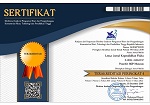Implementasi Perangkat Pembelajaran Fisika Berbasis Pembelajaran Inkuiri dengan Strategi Konflik Kognitif untuk Melatihkan Kemampuan Berpikir Kritis
DOI:
https://doi.org/10.33394/j-lkf.v5i2.512Keywords:
Inquiry Learning, Conflict Cognitive Strategy, Critical Thinking AbilityAbstract
[Title: Implementation of Physics Learning Tools Based on Inquiry Learning with Conflict Cognitive Strategies to Facilitate Critical Thinking Ability]. This study aims to implement physics learning device based on inquiry with conflict cognitive strategy to facilitate student’s critical thinking on the fluid material. The device is implemented in the first semester students of Physics Education Study Program IKIP Mataram academic year 2017/2018 with test design using one group pre-test post-test design. Data collection methods used were questionnaires, tests, and observations, while data analysis techniques used qualitative and quantitative descriptive analysis. The results of the implementation obtained some findings, namely: learning activities can be done well with the high degree of reliability. Student response to learning is very positive with the interest of students to follow the learning. The students' critical thinking skills after the experimentally developed learning tools are critically developed. Based on the results of this study can be concluded that learning tools that are implemented practical, and effectively used to facilitate students' critical thinking skills.References
Alexander, P. A. (1996). The Past, the Present and Future of Knowledge Research: A Reexamination of the Role of Knowledge in Learning and Instruction. Educational Psychologist, - (31), 89–92.
Arends, R. (2012). Learning to Teach. Ninth Edition. New York: McGraw-Hill.
Bonwell, C. C. & Eison, J. A. (1991). Active learning: Creating Excitement in the Classroom. ASHE-ERIC Higher Education Report No. 1. Washington, DC: George Washington University.
Depdiknas. (2006). Peraturan Menteri No 22/2006: Standar Isi untuk Satuan Pendidikan Dasar dan Menengah. Jakarta: BSNP.
Devi., Sofiraeni., & Khairuddin. (2009). Pengembangan Perangkat Pembelajaran untuk Guru SMP. Jakarta: Pusat Pengembangan dan Pemberdayaan Pendidik dan Tenaga Kependidikan Ilmu Pengetahuan Alam (PPPPTK IPA) untuk Program Bermutu.
Duron, H., Limbach B., & Wough W. (2006). Critical Thinking Framework to Any Disciplineâ€. International Journal of Teaching and Learning in Higher education. 17(2), 160-166.
Dwijananti & Yuliyanti. (2010). Pengembangan Kemampuan Berpikir Kritis Mahasiswa Melalui Pembelajaran Problem Based Instruction Pada Mata Kuliah Fisika Lingkungan. Jurnal Pendidikan Fisika Indonesia. 6(-), 108-114.
Ennis, R. H. (1996). Critical Thinking. New York: Prentice-Hall.
Facione, P., A. (1991). Critical Thinking: A statement of Expert Consensus for Purposes of Educational Assessment and Instruction. The California Academic Press.
Fink, L. D. (2003). A Self-Directed Guide to Designing Courses for Significant Learning. San Francisco: Jossey-Bass, In Press.
Hammer, D. (1994). Epistemological Beliefs in Introductory Physics. Cognition and Instruction, - (12), 151–183.
Harkreader, H. (2000). Fundamental of nurse caring and Clinical Judgment. Philadelphia: W.B. Sunders Company.
Ibrahim, M. (2008). Model Pembelajaran Inovatif IPA Melalui Pemaknaan. Unesa. Surabaya: Tim Balitbang Diknas.
Ibrahim, M. & Wahyusukrtiningsih. (2014). Model Pembelajaran Inovatif Melalui Pemaknaan, (Belajar Perilaku Positif dari Alam). Surabaya: Unesa University Press.
Karen, A. (2006). What Is Critical Thinking. UTC Workshop.
Lawson. (1995). Using The Learning Cycle to Teach Biology Concepts and Reasoning Patterns. Journal of Biological Education, 35(4), 165-169.
Nieveen, N. (1999). Prototyping to Reach Product Quality. Kluwer Academic Publisher.
Phan, H. (2010). Critical Thinking As a Self-Regulatory Process Component in Teaching And Learning. Psycothema. - (22), 289-292.
Pintrich, P. R. (1999). Motivational Beliefs as Resources for and Constraints on Conceptual Change. In W. Schnotz, S. Vosniadou, dan M. Carretero (Eds.), New perspectives on conceptual change. Amsterdam: Pergamon.
Pintrich, P. R., Marx, R. W., & Boyle, R. A. (1993). Beyond Cold Conceptual Change: The Role Of Motivational Beliefs and Classroom Contextual Factors in the Process of Conceptual Change. Review of Educational Research, 63(2), 167–200.
Prayogi, S. (2013). Implementasi Model Inquiry untuk Mengembangkan Kemampuan Berpikir Kritis Mahasiswa Pendidikan Fisika. Laporan Hasil Penelitian. LPPM IKIP Mataram.
Prayogi, S., & Asy’ari, M. (2013). Implementasi model PBL (problem based learning) untuk meningkatkan hasil belajar dan kemampuan berpikir kritis siswa. Prisma Sains : Jurnal Pengkajian Ilmu dan Pembelajaran Matematika dan IPA IKIP Mataram, 1(1), 80-88. Retrieved from http://ojs.ikipmataram.ac.id/index.php/prismasains/article/view/521/485
Riduwan. (2010). Skala pengukuran variabel-variabel penelitian. Bandung: Alfabeta.
Santrock, J.W. (2011). Educational Psychology Fifth Edition. Dallas: University of Texas.
Setyowati, Subali & Mosik. (2011). Implementasi Pendekatan Konflik Kognitif dalam Pembelajaran Fisika untuk Menumbuhkan Kemampuan Berpikir Kritis Siswa. Jurnal Pendidikan Fisika Indonesia. 7(-), 89-96.
Sidartha, A. (2010). Model Pembelajaran Asam Basa Berbasis Inkuiri Laboratorium Sebagai Wahana Pendidikan Sains Siswa SMP.
Wenno, I. (2008). Praktikum Fisika dengan Menggunakan LKS Competence Based Process Skill sebagai Alat Evaluasi. Jurnal Kependidikan. 38(1)
Woolfolk, A. (2009). Educational Psychology. Bagian Pertama. New York: Pearson.
Yuliati, Yulianti, & Khanafiyah. (2011). Pembelajaran Fisika Berbasis Hands on Activities untuk Menumbuhkan Kemampuan Berpikir Kritis dan Meningkatkan Hasil Belajar Siswa SMP. Jurnal Pendidikan Fisika Indonesia. – (7), 23-27.
Zeidler, D. L. (1997). The Central Role of Fallacious Thinking in Science Education. Science Education. -(81), 483–496.
Downloads
Published
How to Cite
Issue
Section
License
Authors who publish with Lensa: Jurnal Kependidikan Fisika agree to the following terms:
- For all articles published in Lensa: Jurnal Kependidikan Fisika, copyright is retained by the authors. Authors give permission to the publisher to announce the work with conditions. When the manuscript is accepted for publication, the authors agree to automatic transfer of the publishing right to the publisher.
- Authors retain copyright and grant the journal right of first publication with the work simultaneously licensed under a Creative Commons Attribution-ShareAlike 4.0 International License that allows others to share the work with an acknowledgment of the work's authorship and initial publication in this journal.
- Authors are able to enter into separate, additional contractual arrangements for the non-exclusive distribution of the journal's published version of the work (e.g., post it to an institutional repository or publish it in a book), with an acknowledgment of its initial publication in this journal.
- Authors are permitted and encouraged to post their work online (e.g., in institutional repositories or on their website) prior to and during the submission process, as it can lead to productive exchanges, as well as earlier and greater citation of published work (See The Effect of Open Access).

This work is licensed under a Creative Commons Attribution-ShareAlike 4.0 International License.



